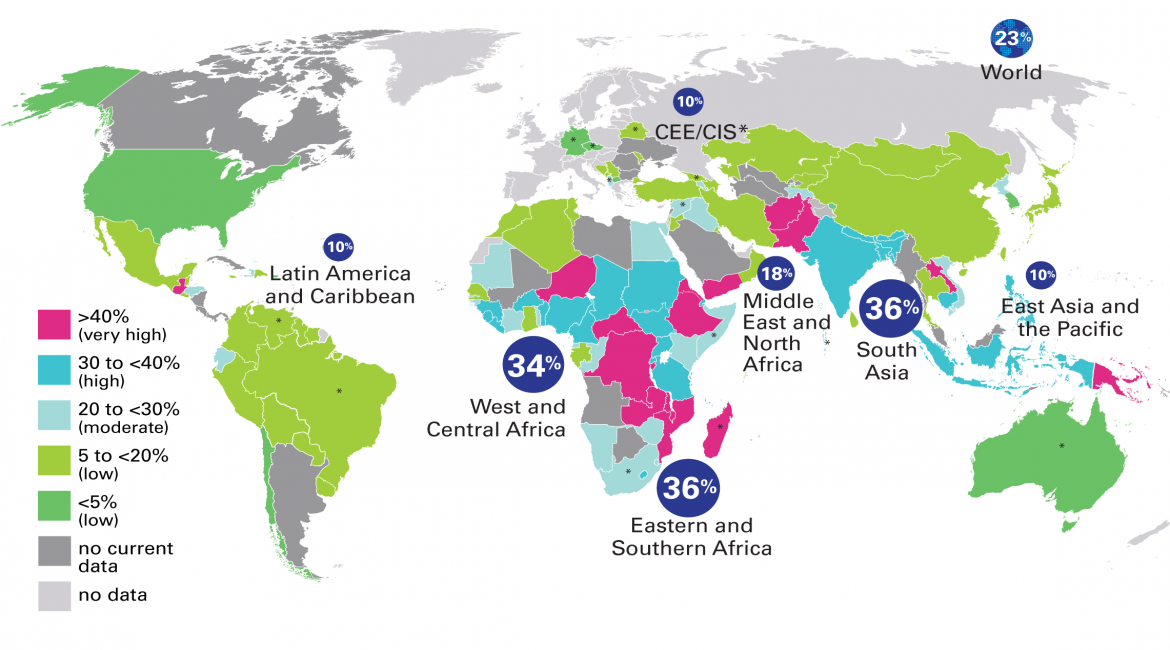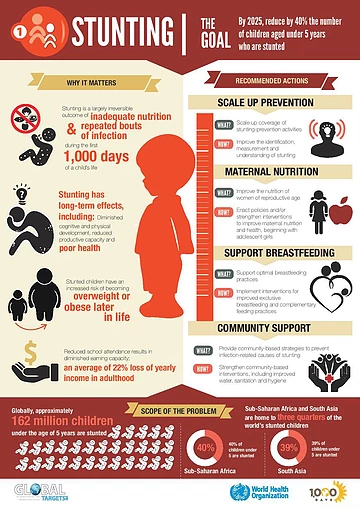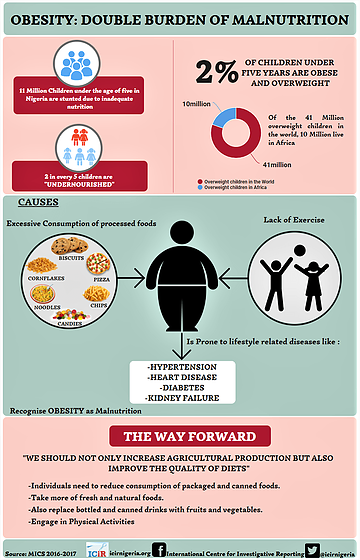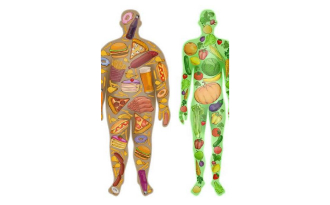Double Burden Malnutrition

Double Burden of Malnutrition:
The double burden of malnutrition means both undernutrition and obesity, or diet-related diseases, which can affect individuals, at household levels, or the whole society, and especially observed in developing countries.
According to WHO, undernutrition and obesity are amongst the top ten leading factors to the global burden of disease (WHO, 2002). Malnutrition is mainly influenced by economic and income growth, urbanization, quality and quantity of food, lifestyle, etc.
Factors, which contribute to double burden malnutrition:
According to WHO, more than 1.9 billion people worldwide were #overweight in 2014, 462 million were underweight, and more than 600 million were obese. In the same year, 42 million children under the age of five became overweight or obese. Around 50 million children were affected by wasting and around 156 million by stunting.
Main causes of the double burden of malnutrition are:
-
Nutritional changes: In urban areas, economic development leads to changes in the food habit and calorie intake of the population. This results in becoming overweight, obesity and noncommunicable diseases (NCDs). On the other hand, the rural population are affected by undernutrition due to lack of food and supplements, etc.

-
Epidemiological changes: Developing countries are mainly affected by undernutrition, overnutrition and NCDs due to their population growth rates and socio-economic transition.
-
The social environment: In rural areas, child-marriage is still a major problem that affects the maintenance of child stunting levels. In urban areas, children consume processed foods and soft drinks that directly affect their health.
-
Physical Activity: With urbanization, people expend less energy during their daily life activities.
Effectivity of “Sugar Tax”:
`sugar tax` is the tax which is mainly used to reduce consumption of drinks with added sugar. Carbonated soft drinks, sports drinks, and energy drinks are the main examples. Many countries have implemented this tax on soft drinks. There are several causes leading to such action:
-
Health issue: Type II Diabetes, which is the most common problem throughout the world. Obesity is most commonly linked to diabetes. Consumption of sugar-sweetened beverages and soft drinks leads to obesity, especially in teenagers. Therefore, food awareness is the main cause of this tax.
-
Economic issue: `Sugar tax` is the way to reduce the consumption of sugar intake. If the customer feels that raised tax is mainly utilized for health care or education about healthy eating, they will appreciate the taxation process.
In every taxation policy, there are some advantages and disadvantages.
In this policy, the disadvantages are:
-
Effect of the low-income group
-
Chances of losing jobs
-
The design of this tax is not proper so, many drinks with high sugar content pay lower taxes.
Advantages are:
-
Awareness about diet consumption
-
Public health benefit
-
There are strong social and economic benefits from the sugar tax. Through this process, people are made aware of food or drink habits. On the other hand, the money raised through the tax can be invested in the development of health programs or treatment of health problems like obesity, diabetes, heart disease.
Overweight and underweight in the same family:
Undernourished (stunted, underweight) and overnourished (overweight, obese) members in the same family are called dual burden at the household level.
According to WHO, many lower and middle-income groups people in developing countries are affected by this problem. Factors which influenced this problem are:
-
Maternal issue: Mother’s age, health condition, and lifestyle.
-
Financial Status: Lifestyle and
 food habits change according to the financial status of people. If low and middle-income groups, and teenagers, can purchase high-calorie, processed food at reasonable prices then they are easily attracted to it.
food habits change according to the financial status of people. If low and middle-income groups, and teenagers, can purchase high-calorie, processed food at reasonable prices then they are easily attracted to it.
-
Gender: Even today, people prefer a male child than a female child in their family, especially in the rural areas of some developing countries.
-
Lack of education: People are unaware of what kind of food is beneficial for health, and what is not. Low or middle-income groups are more affected by this.
Relation of over and under-weight with gut microbiota:
-
Childhood undernutrition and obesity are functionally linked with the gut microbiome.
-
Bifidobacteria found in the gut of breastfed infants, which form short-chain fatty acid, helps to inhibit pathogens. Low level of these bacteria associated with diarrhea, malabsorption.
-
High sugar, a fat content of food, changes the composition of the gut microbiome. The decrease in the level of Bacteroidetedes and Akkermansia related microbes, and an increase in the level of Firmicutes and Proteobacteria related microbes may cause inflammation potentially leading to obesity or obesity-related disease.
-
Underweight in children leads to immature gut microbiota. Ruminococcus and Clostridium type of bacteria are absent in underweight people thereby causing reduced production of the energy-rich, short-chain fatty acid butyrate.
Reasons behind some children are underweight, wasted or stunted and become obese in later life:
In the case of undernourished children, gut microbiota becomes immature which inhibits the source of energy.
Socio-economic changes in developing countries change people’s lifestyles. Dietary habits evolve independently from genetic relatedness. The microbiota composition is influenced by both diet and host genetics. Due to secondary lifestyle and fatty food habits, people become obese. Gut microbiota changes accordingly potentially leading to inflammation. This can lead to obesity or obesity-related diseases.
Improving the gut microbiota of children:
For healthy infants, the following factors influence microbiota:
-
 Food habits: In developing countries, children are attracted to high-calorie food and processed food with high-fat content. It has been shown that a restricted amount of calorie intake helps to maintain a healthy body. Fatty food increases the level of Firmicutes and Proteobacteria related microbes, leading to obesity.
Food habits: In developing countries, children are attracted to high-calorie food and processed food with high-fat content. It has been shown that a restricted amount of calorie intake helps to maintain a healthy body. Fatty food increases the level of Firmicutes and Proteobacteria related microbes, leading to obesity. -
Prebiotic: Prebiotics are fibers, which not digested in the small intestine and partially or completely fermented by gut microbiota in the colon. Oligosaccharides are the most common pre-biotics, which help in production short-chain fatty acid, which is a source of energy. Pre-biotics also help to stimulate bowel movement and stimulate beneficial gut microbes, which improve gastric health.
-
Probiotics: Probiotics are microorganisms, which have beneficial effects after consumption. It helps to improve the immune system and prevent infection to pathogens. Studies have shown that it helps in the treatment of lactose intolerance, post-antibiotic diarrhea, and chronic bowel inflammatory disease.
-
Synbiotics: Syn-biotics is also known as `synergy` which is the mixture of pro and pre-biotic. Foods that contain these two helps to improve the activity of microbes in the gut to protect against pathogens. Additionally, the probiotic on arriving in the large intestine can immediately start the fermenting process, which improves gut health.
Importance of WHO’s advice regarding this matter:
WHO’s advice can help increase awareness of parents about the importance of gut microbiota in child nourishment via the school education program, and promotion of maternal, infant and child health.












0 Comments